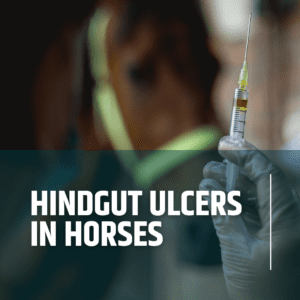Understanding Impaction Colic
Impaction colic is a common and potentially serious condition in horses, characterised by a blockage in the intestines due to firm, dry masses of feed material. Given the sensitivity of the equine digestive system, understanding and managing this condition is crucial for horse owners.
Key Characteristics:
- Location: Typically occurs in the large colon, where feed material becomes compacted.
- Symptoms: Include decreased faecal production, signs of abdominal pain, loss of appetite, and changes in behaviour.
- Causes: Often linked to dehydration, poor quality or low-fibre diet, dental problems, or reduced physical activity.
Seasonal Risks in Winter
The incidence of impaction can increase in winter due to environmental and management changes:
1. Reduced Water Intake: Horses tend to drink less in colder weather, leading to dehydration and drier faeces [1].
2. Dietary Changes: Hay-based diets in winter can lead to decreased gut motility compared to fresh pasture [2].
3. Reduced Activity: Limited exercise can decrease intestinal motility, increasing the risk of impaction [3].
4. Cold Stress: The need for more energy in cold weather, combined with less efficient digestion, can contribute to digestive issues [4].
Management and Prevention Strategies
1. Hydration: It's essential to encourage horses to drink enough water, possibly by heating water sources or adding salt to their diet.
2. Diet: High-fibre diets with adequate roughage can help maintain gut health. Assess the quality of hay and consider soaking it to increase moisture.
3. Exercise: Regular exercise is key in maintaining digestive function.
4. Dental Care: Routine dental checks ensure horses can chew and digest feed effectively.
5. Monitoring: Keep an eye on horses for any changes in feeding, behaviour, or defecation patterns.
Is EquiNectar useful for my horse in this context?
EquiNectar could be a useful addition to your horse’s diet. By supplying digestive enzymes such as amylase, fructanase, and cellulase, it aids in the efficient breakdown of feed in the small intestine. Furthermore, it helps to stabilise the hindgut microbiome. A well-balanced gut microbiome is essential for overall wellbeing.
References
1. Hillyer, M. H., Taylor, F. G. R., & Proudman, C. J. (2002). "Case-control study to identify risk factors for simple colonic obstruction and distension colic in horses." Equine Veterinary Journal, 34(5), 455-463.
2. Tinker, M. K., White, N. A., Lessard, P., Thatcher, C. D., Pelzer, K. D., Davis, B., & Carmel, D. K. (1997). "Prospective study of equine colic risk factors." Equine Veterinary Journal, 29(6), 454-458.
3. Proudman, C. J., Smith, J. E., Edwards, G. B., & Holdstock, N. B. (1998). "Long-term changes in the faecal flora of horses after large colon torsion." Equine Veterinary Journal Supplement, (27), 45-47.
4. Archer, D. C., & Proudman, C. J. (2006). "Epidemiological clues to preventing colic." Veterinary Journal, 172(1), 29–39.
ABOUT EQUINECTAR
Description
EquiNectar® is a natural feed supplement, that is scientifically proven to:
- Re-balance your horse’s gut bacteria
- Help your horse maximise benefits from its feed
- Improve your horse’s condition
More information
EquiNectar® is produced by Tharos Ltd in the UK. It is a natural source of digestive enzymes and contains only the following ingredients:
- Our patented enzyme rich malt extract
- Medium chain triglycerides (from coconut oil)
- Potassium sorbate
For more details of the enzymes within EquiNectar® take a look at the ingredients and enzymes page.
How to feed
Simply add EquiNectar® to your horse's daily feed, using the Feeding Rate chart to determine the correct amount.
For detailed instructions about how to introduce EquiNectar, please read the comprehensive Feeding Guide page.






